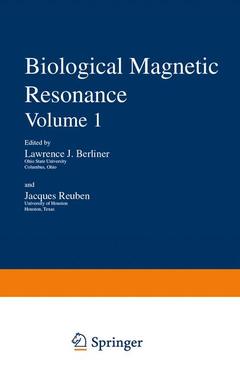Biological Magnetic Resonance, Softcover reprint of the original 1st ed. 1978 Biological Magnetic Resonance Series, Vol. 1
Langue : Anglais
Coordonnateur : Berliner Lawrence

Biological magnetic resonance (NMR and EPR) is a rapidly expanding area of research with much activity in most universities and research institutions. International conferences are held biennially with an increasing number of participants. With the introduction of sophisticated and continuously im proving instrumentation, biological magnetic resonance is approaching the state of a common physical method in biochemical, biomedical, and bio logical research. The lack of monograpbs on the subject had been con spicuous for a long time. This gap started to close only recently. However, because of the rapid expansion and intensive research, many texts are dated by the time of their appearance. Therefore we have undertaken the editing of a series that is intended to provide the practicing chemist, biochemist, or biologist with the advances and progress in selected contemporary topics. In seeking to make the series as authoritative as possible, we have invited authors who have not only made significant contributions but who are also currently active in their fields. We hope that their expertise as well as their first hand experience as reflected in the chapters of this volume will be of benefit to the reader, inter alia, in planning his own experiments and in critically evaluating the current literature.
1 NMR of Sodium-23 and Potassium-39 in Biological Systems.- 1. Introduction.- 2. Theoretical Background.- 3. Relaxation Rates in Simple Aqueous Solution.- 4. Effects of Complexing Agents and Ionophores.- 5. Electrostatic Interactions and Effects of Polyelectrolytes.- 6. Spectra in Ordered Systems.- 7. Measurements in Biological Tissues.- References.- 2 High-Resolution NMR Studies of Histones.- 1. Introduction.- 2. Studies of the Self-Aggregation of the “Core Histones” Using Proton Spectroscopy.- 3. Carbon-13 Studies of Histone Self-Aggregation.- 4. Summary of Histone Self-Aggregation Studies.- 5. Interactions of Single Histones with DNA.- 6. Histone Complexes.- 7. The Lysine-Rich Histone H1.- 8. The Lysine-Rich Histone H5 from Nucleated Erythrocytes.- 9. Marine Invertebrate Sperm H1s ((?1s).- 10. Nonhistone Chromosomal Proteins.- 11. Histone H1 Interactions in Chromatin.- 11.1. Chromatin.- 11.2. H1-DNA.- 11.3. Marine Invertebrate Sperm H1 (?l)/DNA Interactions.- 12. Summary.- References.- 3 PMR Studies of Secondary and Tertiary Structure of Transfer RNA in Solution.- 1. Introduction.- 2. Analysis of Imino Proton Spectra.- 3. Hydrogen Bonding of the 2? OH in tRNA.- 4. Metal Binding and Tertiary Structure.- 5. tRNA-Drug Interactions.- 6. Structure of Denatured tRNA.- 7. Interaction of tRNA with Enzymes.- 8. Concluding Remarks.- References.- 4 Fluorine Magnetic Resonance in Biochemistry.- 1. Introduction.- 2. Characteristics of Fluorine Probes.- 3. Fluorine Magnetic Resonance Experiments.- 4. Peptides and Proteins.- 5. Nucleic Acids.- 6. Micelles, Membranes, and Membrane Models.- 7. Fluorocarbohydrates.- 8. Some Experimental Considerations.- 9. Interpretation of Results.- 10. Conclusions.- References.- 5 ESR of Free Radicals in Enzymatic Systems.- 1. Introduction.-2. Methods used to Study Free Radical Intermediates.- 3. Enzyme Free-Radical Intermediates: The Flavoenzymes.- 4. Substrate Free-Radical Intermediates in Enzymic Catalysis.- 5. Summary.- References.- 6 Paramagnetic Intermediates in Photosynthetic Systems.- 1. Introduction.- 2. Techniques and Methodologies.- 3. Paramagnetic Intermediates of the Reaction Center.- 4. Secondary Electron Donors and Acceptors.- 5. Summary.- References.- 7 ESR of Copper in Biological Systems.- 1. Introduction.- 2. Theory of the ESR due to Mononuclear Copper II.- 3. ESR Spectra due to Coupled Copper II Pairs.- 4. ESR of Copper II in Plant and Animal Physiology.- 5. Conclusions.- References.
Date de parution : 02-2013
Ouvrage de 345 p.
15.2x22.9 cm
Thèmes de Biological Magnetic Resonance :
Mots-clés :
Aspartat; DNA; Galactose; NMR; RNA; amino acid; base; biochemistry; carbohydrates; catalysis; enzyme; enzymes; metabolism; nucleic acid; protein
© 2024 LAVOISIER S.A.S.



